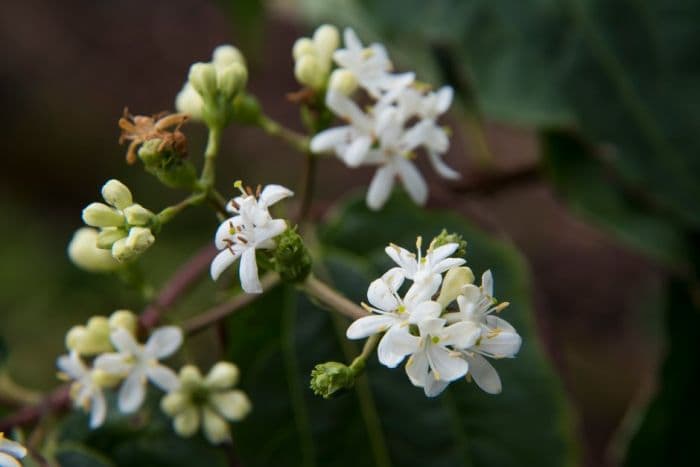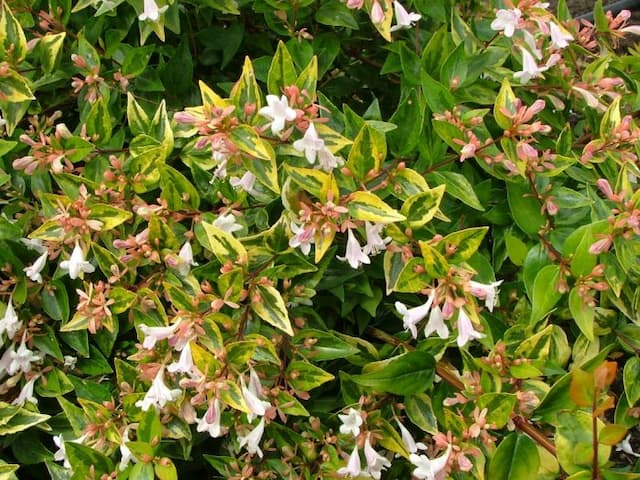Seven-son flower Heptacodium miconioides

ABOUT
The plant commonly known as the seven-son flower features a distinctive appearance with multiple layers of interest throughout the seasons. It starts with a smooth, tan to brown bark that peels away in thin strips to reveal a lighter, almost cream-colored underbark that gives the plant an appealing look, especially in the winter months when the branches are bare. During the growing season, the branches are adorned with glossy, green leaves. They are generally elongated and pointed, creating a lush, almost tropical appearance. As the seasons transition to autumn, the foliage often changes to a soft, attractive yellow color, signaling the change of seasons with its warm hues. The real show begins in late summer to early fall when clusters of small, fragrant, creamy white flowers bloom. Each of these clusters is made up of seven small flowers, giving rise to the common name of the plant. The blooms are a source of nectar for butterflies and other pollinators, adding to the plant's garden value. After the flowers fade, another layer of color emerges: the sepals beneath the flowers enlarge and turn a bright, cherry red. This creates a second flush of color that can be as impactful as the initial flowering, providing visual interest well into the fall season. In a garden setting, this plant typically shows a rounded to vase-shaped form with multiple stems, giving it an airy and open structure. This nature allows it to be a standout feature or an attractive backdrop for other plants in a mixed border. With its layered features and extended season of interest, it is a beloved choice for gardeners looking to add a plant with both beauty and resilience.
About this plant
 Names
NamesFamily
Caprifoliaceae
Synonyms
Seven-Son Flower, Autumn Lilac
Common names
Heptacodium jasminoides.
 Toxicity
ToxicityTo humans
The plant Heptacodium miconioides, also known as Seven-Son Flower, is not commonly known to be toxic to humans. There is limited information on reports of poisoning or adverse health effects from ingestion or contact with this plant. It is always prudent, however, for individuals to avoid ingesting parts of ornamental plants due to potential unknown risks or individual sensitivities.
To pets
Seven-Son Flower, or Heptacodium miconioides, is not widely recognized as a toxic plant to pets such as dogs and cats. There is scarce evidence and few reports regarding its toxicity in domestic animals. Nevertheless, pet owners should supervise their animals and prevent them from consuming plants that are not intended for consumption, as individual reactions can vary and some pets may experience gastrointestinal upset or other symptoms from ingesting non-food plants.
 Characteristics
CharacteristicsLife cycle
Perennials
Foliage type
Deciduous
Color of leaves
Green
Flower color
White
Height
15-25 feet (4.6-7.6 meters)
Spread
10-15 feet (3-4.6 meters)
Plant type
Shrub
Hardiness zones
5-9
Native area
China
Benefits
 General Benefits
General Benefits- Ornamental appeal: Heptacodium miconioides, commonly known as the seven-son flower, has attractive peeling bark and fragrant flowers, making it an appealing addition to gardens and landscapes.
- Late-season blooms: This plant blooms in late summer to early fall, providing color when many other plants have finished flowering.
- Bee and butterfly attractant: The blooms of the seven-son flower are a nectar source for bees and butterflies, supporting beneficial insect populations.
- Drought tolerance: Once established, Heptacodium miconioides is known for its drought-resistant qualities, requiring minimal watering in temperate climates.
- Low maintenance: It requires minimal pruning and is relatively pest and disease-resistant, reducing the need for chemical treatments.
- Shade tolerance: This plant can tolerate partial shade, making it versatile for planting in a variety of light conditions within a garden or landscape.
- Wildlife habitat: The foliage provides shelter for birds and other wildlife, while the seeds that follow flowering offer a food source in the late fall and winter.
- Winter interest: Even after its leaves have fallen, the peeling bark and persistent seed capsules of Heptacodium miconioides add texture and interest to winter landscapes.
 Medical Properties
Medical PropertiesThis plant is not used for medical purposes.
 Air-purifying Qualities
Air-purifying QualitiesThis plant is not specifically known for air purifying qualities.
 Other Uses
Other Uses- Wildlife Attractant: Seven-sons flower provides nectar and pollen for bees, butterflies, and other pollinators, enhancing biodiversity in the garden.
- Hedging and Screening: Its dense, branching habit allows it to be used as a privacy hedge or screen.
- Erosion Control: The Seven-sons flower can be planted on slopes or areas prone to erosion to help stabilize soil with its root system.
- Specimen Plant: With its distinct flowers and peeling bark, it can serve as a focal point in residential and institutional landscapes.
- Photography: The plant's unique appearance, particularly when in bloom, makes it a subject of interest for garden photographers.
- Winter Interest: The peeling bark and persistent seed capsules add visual appeal to the winter garden when most plants are dormant.
- Education: Seven-sons flower can be used in educational settings such as botanical gardens to demonstrate plant biodiversity and evolution.
- Cultural Practices: In China, it is sometimes planted in graveyards, capitalizing on its late season blooms that are culturally seen as symbolizing resilience and respect for ancestors.
- Artistic Inspiration: Artists may use the intricate structure of the Seven-sons flower in drawings, paintings, and other forms of artwork.
- Bonsai: The Seven-sons flower can be cultivated as a bonsai, offering a unique challenge due to its normally large size and growth pattern.
Interesting Facts
 Feng Shui
Feng ShuiThe Seven Son Flower is not used in Feng Shui practice.
 Zodiac Sign Compitability
Zodiac Sign CompitabilityThe Seven Son Flower is not used in astrology practice.
 Plant Symbolism
Plant Symbolism- Resilience: Heptacodium miconioides, commonly known as the Seven-Son Flower, often symbolizes resilience due to its ability to thrive in a variety of conditions and withstand harsh environments.
- Renewal: The plant’s ability to bloom late in the season when most other plants have finished flowering can symbolize renewal and the promise of new beginnings.
- Beauty in Simplicity: With its understated white flowers that bloom in late summer to early fall, the Seven-Son Flower is often associated with the notion that there is beauty in simplicity and subtlety.
- Adaptability: As a plant that can adapt to different growing conditions and even grow in urban settings, the Seven-Son Flower can represent adaptability and versatility in life.
 Water
WaterThe Seven-Son Flower requires regular watering, particularly during dry spells. In the growing season, water it deeply once a week, ensuring you're soaking the soil around the root zone. If you're watering a newly planted shrub, provide 1 to 2 gallons per week until the plant is established. Established plants will require less frequent waterings, depending on rainfall and soil conditions, but ensure the soil doesn't dry out completely. During extreme heat, an additional watering may be needed to prevent stress.
 Light
LightSeven-Son Flowers thrive in full sunlight to partial shade. The ideal location provides at least 4 to 6 hours of direct sun each day, ensuring the plant receives ample light for vigorous growth and flowering. If placed in too much shade, the plant may become leggy and produce fewer flowers, so opt for a spot with generous morning sunlight and some afternoon shade, especially in hotter climates.
 Temperature
TemperatureThe Seven-Son Flower is hardy in USDA zones 5 through 9, tolerating a range of temperatures. It prefers a temperature range of 60 to 75°F for optimal growth but can survive winter temperatures down to -20°F. During summer, the plant can tolerate temperatures up to around 90°F without significant stress. Ensure proper mulching to protect the root system from extreme temperature fluctuations.
 Pruning
PruningPruning the Seven-Son Flower should be done to shape the plant, remove dead wood, and encourage healthy growth. The best time for pruning is late winter or early spring before new growth starts. Prune selectively, cutting back to a healthy set of outward-facing buds. Thinning out older branches every few years also encourages better air circulation and light penetration, leading to a more robust plant.
 Cleaning
CleaningAs needed
 Soil
SoilSeven Sons Tree thrives in well-draining soil with a pH range between 5.5 and 7.0. A good soil mix for optimal growth would include a blend of garden soil, compost, and a small amount of perlite or sand to enhance drainage. Regularly amending the soil with organic matter will help to maintain the necessary soil structure and fertility.
 Repotting
RepottingSeven Sons Tree does not commonly require repotting as it is typically grown as a landscape plant rather than in containers. However, if grown in pots, young plants may need repotting every 2 to 3 years or when they outgrow their current container.
 Humidity & Misting
Humidity & MistingSeven Sons Tree is adaptable to a wide range of humidity levels and does not have specific humidity requirements. It will thrive in the average outdoor humidity levels found in its growing zones.
 Suitable locations
Suitable locationsIndoor
Ensure ample light and space; not ideal for indoor growth.
Outdoor
Sunlight and well-drained soil; water regularly; protect from harsh winds.
Hardiness zone
5-9 USDA
 Life cycle
Life cycleHeptacodium miconioides, commonly known as Seven-Son Flower, begins its life cycle as a seed that, once dispersed, germinates when conditions are appropriate—usually in the spring. Seedlings establish a taproot system and begin to produce leaves to photosynthesize. As it matures into a shrub or small tree, Heptacodium miconioides experiences vegetative growth, developing branches and foliage through the spring and summer months. In late summer to early autumn, it enters its reproductive stage, blooming with fragrant, white flowers that are attractive to pollinators. Following pollination, these flowers give way to small, non-edible, reddish-purple drupes (fruit) in late autumn, while the calyces beneath the flowers turn a bright red. During the winter, the plant becomes dormant, shedding its leaves and conserving energy until the next growing season.
 Propogation
PropogationPropogation time
Spring-summer
The most popular method of propagation for the Seven-son flower, Heptacodium miconioides, is by semi-hardwood cuttings taken in mid to late summer. Choose healthy stems that are not yet woody and cut them into lengths of about 4 to 6 inches (about 10 to 15 centimeters). At the bottom end of the cutting, remove the leaves from the lower third to create a clean area for rooting. The cut end should then be dipped in a rooting hormone to encourage root development. Afterward, insert the cutting into a well-draining potting mix, ensuring that at least one set of leaf nodes is below the surface. The cutting should be kept moist and in partial shade until roots are established, which typically takes several weeks. Ensure a high humidity environment such as by enclosing the pot in a clear plastic bag with some ventilation to prevent fungal growth, while allowing for some air circulation.

![Abelia [Sunshine Daydream]](/_next/image?url=https%3A%2F%2Fplants-admin.emdemapps.com%2Fimages%2Fplants%2F%2Fimages%2F604b61a1e9cdd.png&w=640&q=75)







